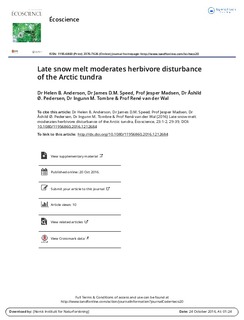| dc.contributor.author | Anderson, Helen B. | |
| dc.contributor.author | Speed, James David Mervyn | |
| dc.contributor.author | Madsen, Jesper | |
| dc.contributor.author | Pedersen, Åshild Ønvik | |
| dc.contributor.author | Tombre, Ingunn | |
| dc.contributor.author | van der Wal, René | |
| dc.coverage.spatial | Svalbard | nb_NO |
| dc.date.accessioned | 2016-10-24T09:16:22Z | |
| dc.date.accessioned | 2016-11-22T11:12:03Z | |
| dc.date.available | 2016-10-24T09:16:22Z | |
| dc.date.available | 2016-11-22T11:12:03Z | |
| dc.date.issued | 2016 | |
| dc.identifier.citation | Ecoscience 2016, 23(1-2):29-39 | nb_NO |
| dc.identifier.issn | 1195-6860 | |
| dc.identifier.uri | http://hdl.handle.net/11250/2422404 | |
| dc.description.abstract | Resilience of tundra vegetation to disturbance by herbivores can be low and lead to ecosystem
state shifts. Pink-footed geese Anser brachyrhynchus are the most numerous herbivore on
Svalbard and disturb vegetation when foraging for below-ground plant biomass (grubbing).
We assessed grubbing extent (occurrence of vegetation disturbance) and intensity (proportion
of vegetation disturbed) in 2006/07/08 when goose numbers were approximately 56,000 and in
2013 when they increased to approximately 81,000. Despite a 36% increase in population size, in
2013 the grubbing extent at pre-breeding sites was similar to that in 2007/08 but grubbing
intensity was lower. Extensive snow cover in 2013 probably dispersed geese over larger areas in
search of snow-free patches for feeding, thereby reducing grubbing intensity. At the largest
known breeding site, both grubbing extent and intensity increased with more geese. Birds
preferentially fed close to nests in previously grubbed wet habitat, probably aiding nest defence
and permitting feeding on plants that were easier to remove from the soil. A greater impact on
tundra vegetation may occur at nesting areas if the breeding population continues to grow.
However, timing of snowmelt appears key in moderating the impact of disturbance on tundra
vegetation since it controls spatial distributions of feeding geese.
Herbivory; vegetation shifts;
population increase;
environmental factors;
climatic change;Herbivorie; changements de
végétation; augmentation
de population; variables
environnementales;
changement climatique | nb_NO |
| dc.language.iso | eng | nb_NO |
| dc.rights | Navngivelse 3.0 Norge | * |
| dc.rights.uri | http://creativecommons.org/licenses/by/3.0/no/ | * |
| dc.subject | Herbivory | nb_NO |
| dc.subject | vegetation shifts | nb_NO |
| dc.subject | population increase | nb_NO |
| dc.subject | environmental factors | nb_NO |
| dc.subject | climatic change | nb_NO |
| dc.subject | herbivorie | nb_NO |
| dc.subject | changements de végétation | nb_NO |
| dc.subject | augmentation de population | nb_NO |
| dc.subject | variables environnementales | nb_NO |
| dc.subject | changement climatique | nb_NO |
| dc.title | Late snow melt moderates herbivore disturbance of the Arctic tundra | nb_NO |
| dc.type | Journal article | nb_NO |
| dc.type | Peer reviewed | nb_NO |
| dc.date.updated | 2016-10-24T09:16:22Z | |
| dc.subject.nsi | VDP::Mathematics and natural science: 400 | nb_NO |
| dc.source.pagenumber | 29-39 | nb_NO |
| dc.source.volume | 23 | nb_NO |
| dc.source.journal | Ecoscience | nb_NO |
| dc.source.issue | 1-2 | nb_NO |
| dc.identifier.doi | 10.1080/11956860.2016.1212684 | |
| dc.identifier.cristin | 1393899 | |

